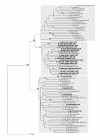Origins of the amphiploid species Brassica napus L. investigated by chloroplast and nuclear molecular markers
- PMID: 20350303
- PMCID: PMC2923528
- DOI: 10.1186/1471-2229-10-54
Origins of the amphiploid species Brassica napus L. investigated by chloroplast and nuclear molecular markers
Abstract
Background: The amphiploid species Brassica napus (oilseed rape, Canola) is a globally important oil crop yielding food, biofuels and industrial compounds such as lubricants and surfactants. Identification of the likely ancestors of each of the two genomes (designated A and C) found in B. napus would facilitate incorporation of novel alleles from the wider Brassica genepool in oilseed rape crop genetic improvement programmes. Knowledge of the closest extant relatives of the genotypes involved in the initial formation of B. napus would also allow further investigation of the genetic factors required for the formation of a stable amphiploid and permit the more efficient creation of fully fertile re-synthesised B. napus. We have used a combination of chloroplast and nuclear genetic markers to investigate the closest extant relatives of the original maternal progenitors of B. napus. This was based on a comprehensive sampling of the relevant genepools, including 83 accessions of A genome B. rapa L. (both wild and cultivated types), 94 accessions of B. napus and 181 accessions of C genome wild and cultivated B. oleracea L. and related species.
Results: Three chloroplast haplotypes occurred in B. napus. The most prevalent haplotype (found in 79% of accessions) was not present within the C genome accessions but was found at low frequencies in B. rapa. Chloroplast haplotypes characteristic of B. napus were found in a small number of wild and weedy B. rapa populations, and also in two accessions of cultivated B. rapa 'brocoletto'. Whilst introgression of the B. napus chloroplast type in the wild and weedy B. rapa populations has been proposed by other studies, the presence of this haplotype within the two brocoletto accessions is unexplained.
Conclusions: The distribution of chloroplast haplotypes eliminate any of the C genome species as being the maternal ancestor of the majority of the B. napus accessions. The presence of multiple chloroplast haplotypes in B. napus and B. rapa accessions was not correlated with nuclear genetic diversity as determined by AFLPs, indicating that such accessions do not represent recent hybrids. Whilst some chloroplast diversity observed within B. napus can be explained by introgression from inter-specific crosses made during crop improvement programmes, there is evidence that the original hybridisation event resulting in to B. napus occurred on more than one occasion, and involved different maternal genotypes.
Figures


References
-
- Food and Agriculture Organisation StatisticalDatabase FAOSTAT. http://faostat.fao.org/
-
- Nagaharu U. Genome analysis in Brassica with special reference to the experimental formation of B. napus and peculiar mode of fertilisation. Jap J Bot. 1935;7:389–452.
-
- Olsson G. Species crosses within the genus Brassica. II. Artificial Brassica napus L. Hereditas. 1960;46:351–86.
-
- Ozminkowski RH, Jourdan P. Comparing the resynthesis of Brassica napus by interspecific somatic and sexual hybridisation. 1. Producing and identifying hybrids. J Am Soc Hort Sci. 1994;119:808–815.
-
- Parkin IAP, Sharpe AG, Keith DJ, Lydiate DJ. Identification of the A and C genomes of amphidiploid Brassica napus (oilseed rape) Genome. 1995;38:1122–1131. - PubMed
Publication types
MeSH terms
Substances
Grants and funding
LinkOut - more resources
Full Text Sources
Other Literature Sources

